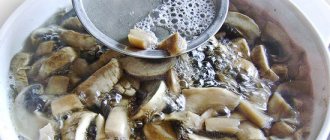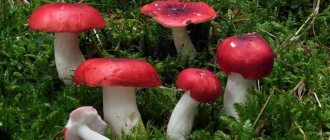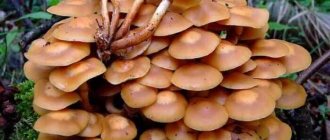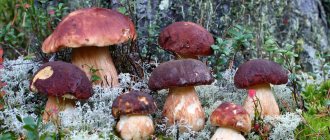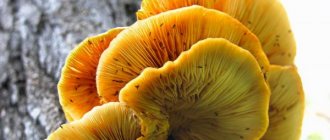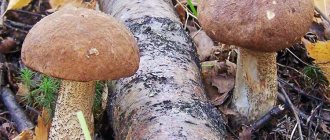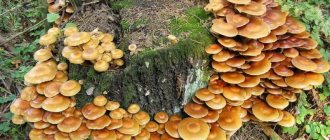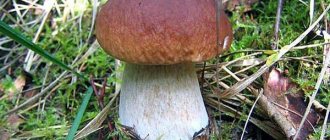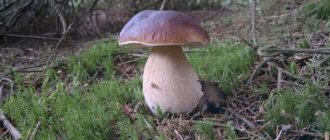Mushrooms
0
2107
Article rating
Kira Stoletova
Mushrooms are a special group of living organisms that contain a huge amount of protein. They are sold at the market or in a store, but it is much more pleasant to pick mushrooms yourself in September.
Mushrooms in September
Variety of autumn mushrooms
Many mushrooms grow in the fall, but they can all be divided into three categories:
- Common summer-autumn mushrooms that bear fruit throughout the snow-free period. But some of them appear en masse in the fall - they can well be considered autumn mushrooms.
- Purely autumn mushrooms, mycelium [1]
Mycelium is the underground part of a mushroom or mycelium in a simple way. which develops and accumulates resources over the summer, and throws out fruiting bodies shortly before the first cold weather. - Extreme mushrooms, which also belong to summer-autumn or autumn, but they are not at all embarrassed by low, including sub-zero temperatures at the end of autumn.
There are also mushrooms, the fruiting period of which occurs in the summer and partially covers September. It seems like they can also be classified as autumn mushrooms. However, those ten days of September - when these mushrooms are collected - still show all the signs of summer, and as soon as real autumn begins, the mushrooms stop appearing. Therefore, I will not consider these mushrooms, since I am inclined to consider them summer mushrooms. But even if I agreed to do this, the article would have turned out to be colossal in volume and would not fit into one publication.
I also intend to state that in the following narrative we will talk exclusively about edible mushrooms. It is clear that in the fall, in addition to them, a lot of poisonous and inedible mushrooms appear, but they all require separate consideration.
At what temperature do mushrooms grow in autumn?
High temperature (30-35°) inhibits the growth of fungi. The mechanism of mushroom growth is such that the mycelium begins to develop at a temperature of 20-25°. During this time, it should rain, the mycelium should be saturated with nutrients. And only at a temperature of 6-10° the fruiting body actively grows.
It happens that mushrooms grow in waves after each heavy rain. But it doesn’t happen year after year. It also happens that the year does not indulge in a mushroom harvest. Many mushroom pickers say that mushrooms have their own quirks.
Picking mushrooms is not only a useful activity, but also an exciting one. For many people, quiet walking through forests and beautiful places calms them down. Don’t forget to arm yourself with a knife for cutting mushrooms and a basket, or maybe several.
But if you decide to go mushroom hunting and don’t know whether this mushroom is edible, it is better to ask an experienced mushroom picker to help. Almost all types of mushrooms have false counterparts, which can be extremely dangerous to your health and life.
Obabki
Obabki should be classified as summer or summer-autumn mushrooms, because during this period they are mainly collected. You can read more about these mushrooms - about their places of growth and fruiting periods - in the following articles:
- Boletus mushrooms: what they are, where they grow and when to collect them;
- Boletuses: what they are, where they grow and when to collect them (by the way, aspen boletuses - according to the scientific classification - are also little boletuses).
However, some of these mushrooms produce fruit even in late October. Next, I intend to look at the most “autumn” of the little things.
Obabok is harsh
It is also a harsh boletus or poplar boletus. So named for its very dense pulp.
It grows under poplars and aspens, in places with calcareous, loamy and sandy soils, but is quite rare. Fruits from late July to November .
Marsh boletus
Photo by: Olev Mihkelmaa
Known for its light color, through which the typical boletus tones barely show through, its love for damp places and loose pulp (especially after heat treatment).
It grows under birch trees - on the outskirts of swamps, in damp mixed forests, on mossy litter. It bears fruit throughout the snowless period (according to rumors, it can appear even in May, so it can also be classified as a spring mushroom). In autumn, this mushroom can be found in the forest almost until the very first snow.
Black boletus
Outwardly, it is the complete antipode of the previous mushroom, but in everything else it is almost similar to it - it also loves damp places and can appear in the midst of autumn.
I myself periodically observed this mushroom in the forests in late autumn - when the trees were bare and the first snowflakes were flying in the air.
White boletus
What’s interesting is that among boletuses there is also a light variety that loves damp places and is quite cold-resistant.
White boletus is a rare mushroom that bears fruit from June to September , but it can be found in the forest until the very first snow. Due to the lack of knowledge, it is not known exactly what trees it enters into symbiosis with. According to one version - with conifers, according to another - with birch.
Boletus yellow-brown
Mostly yellow-brown boletus is harvested in the summer, most en masse at the end of the season. However, its fruiting bodies, just like the previous mushroom, continue to appear until the first snow. Mycorrhiza [2]
Mycorrhiza is a union of a fungus and a higher plant (for example, a tree). The essence of this symbiotic union is that the mycelium entangles the root of the plant and penetrates it. Next, a mutually beneficial exchange takes place between the fungus and the plant: the former provides water and minerals in abundance - much more than the plant could extract from the soil. It does not remain in debt and supplies the mushroom with valuable organic substances - carbohydrates, amino acids, etc. it forms with birch.
Useful properties of mushrooms
Mushrooms contain a large number of useful macro- and microelements, vitamins and minerals that are beneficial to the human body.
Potassium, phosphorus, iron and sodium in one serving of autumn mushrooms are enough to replenish the daily requirement required for a person.
Eating them regularly stabilizes the functioning of the entire body and improves its functions. They contain high-quality proteins and amino acids, such as alanine, threoniline, lysine, stearic and glutamic acids, as well as natural antibiotics. Such a set of useful substances necessary for the human body is not found in any other living organism.
With low calorie content, they quickly cause a feeling of fullness. This is due to the high protein content in them, which is several times more than in meat and eggs. The average calorie content of 100 g of champignons is 25 kcal, white - 35 kcal, and russula only 18 kcal. They are useful when following a diet. However, it is important not to forget that during any type of cooking, the calorie content of mushrooms changes, and not in the direction of decrease.
Forest gifts are useful for strengthening the nervous system due to their high content of B vitamins. They strengthen hair and nails and promote skin regeneration.
They are indispensable for strengthening the circulatory system. Under their influence, the walls of blood vessels restore their elasticity and ability to perform “professional activities.” Melanin in mushrooms serves as a natural antioxidant.
Butter
Once I had the opportunity to collect boletus in the third ten days of October. The culmination of autumn was frosty, the first snow was in no hurry. In the young pine forests - on the frozen “petrified” litter, among brittle, frost-covered grass - there were thousands of “freshly frozen” boletus, among which there were almost no worms. Nobody collected them, since people considered these mushrooms to be already spoiled. But in vain. After all, they were frozen once and have not yet been thawed. Yes, in the heat they became loose and dark, but they smelled good during cleaning. However, in boiling water, the butter quickly lightened and released all its aroma into the broth. The mycelium turned out to be breathtaking, and as it seemed to me then, even tastier than the one I ate in the summer - made from fresh, not frozen mushrooms.
Butterflies are another mushroom that grows in the fall, and at times they can be collected before the very first frost or even from under the snow. The main thing is that the weather is calm and clear.
You can read more about boletus mushrooms in the article: “Boletus mushrooms: 25 varieties.” In the list below I will describe the most autumn ones.
Summer oil can
He is also a grainy butterdish , an early butterdish .
Mycorrhiza forms with pine , bears fruit from June to October , but sometimes it is observed in the second half of May (for which, it would probably be worth classifying it as a spring mushroom) and early November.
Clinton grease can
Named in honor of the American naturalist, this mushroom is popularly known as chestnut oiler or girdled oiler , but most often it is confused with the very similar larch oiler.
Clinton's oil can grows under larches . Fruits from July to October .
Oil can Nyusha
Another mushroom named after the scientist - a German botanist.
Just like the previous butterdish - it forms mycorrhiza with larches . Distributed very widely in the temperate zone of the continent; it likes to climb high into the mountains. Fruits from July to October .
Swamp oil can
He is also the yellow swamp butterdish . It has a very expressive, memorable color towards yellow and golden tones. Purely autumn mushroom.
A lover of damp lowlands, river floodplains, the edges of lakes and swamps - all those places where it is more humid. Mycorrhiza forms with Scots pine and some other double-leaved pines. Fruits from September to October .
Oil can sour
It has somewhat loose pulp and is inferior in taste to ordinary boletus. The mucus covering its cap has a sour taste, which is how the mushroom got its name.
Mycorrhiza forms with five-coniferous pines, including Siberian cedar . Very common in Western Siberia. Fruits from July to early October .
Oil can yellowish
The lower surface of the cap of this mushroom has a pleasant ocher tint.
Distributed quite widely, found both in Eurasia and North America. Grows under double-leaved pines , including common pine . Fruits from June to October .
There is information that the skin of the cap of this butter dish has powerful laxative properties, so it should be peeled off before cooking.
Red-red oil can
He is also known as the Trentian butter dish, the Tridentine butter dish, known for its good taste.
A very rare mushroom that forms mycorrhiza with larches. The fruiting period is from June to October .
Description of later varieties
Forests in late autumn are no less attractive in terms of “silent hunting”. And even if we are not talking about the former diversity, going for mushrooms at the end of October and November will also give good results.
Autumn stitch
In late autumn, in the coniferous forests, on the remains of rotten wood and former fire pits, whole clearings of curly stitches appear with their cartilaginous body, which in its raw form has no aroma.
Typically, these fungi do not reach large sizes; they are used as food whole, but only after soaking and boiling until fully cooked, otherwise there is a risk of being poisoned by their toxic substances.
Late oyster mushroom
Despite its conditional edibility, which is justified by not the highest organoleptic qualities, oyster mushrooms growing on trees are very tasty when fried. The good news is that it forms entire colonies that can withstand even the first persistent frosts.
But you cannot eat oyster mushrooms raw, unlike champignons, since the substances it contains do not have the best effect on digestion.
Winter honey fungus
Flammulina velvety-footed, also known as winter honey fungus, also withstands sub-zero temperatures. These small yellow fungi do not have a pronounced taste or smell, and are an excellent raw material for preparing aromatic marinades. The variety differs from ordinary honey mushrooms because of its dry, velvety cap to the touch.
Deer mushroom
Larger fruits are produced by this variety, all parts of which are considered equally edible. Just like honey mushrooms, the deer mushroom selects trees, forming entire families on their trunks. It is considered a valuable variety due to its excellent taste and pronounced aroma.
Crowded row
One of the numerous species of the Ryadovkov family, the characteristic features of which include the light brown color of the cap, often covered with earth and other adhering forest debris.
The smooth cap of the variety has a different shape - from spherical to wavy and inverted. Because of its specific aroma, mushroom pickers are not very fond of the row, but it turns out very tasty when fried and pickled.
Gray talker
The shade of the talker's cap, which darkens with increased humidity levels, can vary in a fairly wide range of colors - from smoky gray to rich ash. It differs from other rows in its subtle floral scent, which is largely neutralized by heat treatment.
White
Almost all porcini mushrooms collected in our latitude grow in the fall - you don’t even need to look in reference books to confirm this fact. However, in the summer they are observed to produce the most massive amounts of fruit, and in the fall (until about October ) they are seen less frequently. But they are still collected at this time, and the further south the region, the more often and for longer. There are several varieties of porcini mushrooms that form mycorrhiza with different trees - birches , pines , spruces , oaks and others. You can read more about the places where porcini mushrooms grow in the article “Where porcini mushrooms grow.”
How quickly do mushrooms grow after rain in the fall?
Important: For mushrooms to grow, the soil must be well saturated. It is important that it is warm for some time. Such conditions are favorable for the growth of mushrooms.
Mushrooms grow in different ways. For example, boletus may appear 10 hours after rain. Other mushrooms, especially late autumn ones, will have to wait up to 12 days.
Experienced mushroom pickers are sure that it is not necessary to wait 12-14 days after the rain, you just need to know the good places.
It is also important to go to pick mushrooms when they reach the required size. On average, mushrooms reach medium size in 3-6 days. Full growth up to 12-14 days.
Hedgehogs
Photo 15. Rufous hedgehog. Author: H. Krisp.
Their distinctive feature is unusual needle-like spines on the underside of the cap, instead of the usual plates or tubes.
Photo 16. Variegated hedgehog is a conditionally edible summer-autumn mushroom. Author: H. Krisp.
These mushrooms grow just as well in the fall as in the summer and can last until the first cold weather. They are found in different forests, because they can form mycorrhiza with various trees - both deciduous and coniferous.
Photo 17. Notched hedgehog. Photo by: Bubulcus.
In our country, hedgehogs are not collected everywhere, but in Europe they are considered very edible, and one of the species, the variegated hedgehog , is used as a seasoning.
Old overripe mushrooms
You cannot collect and eat old overripe specimens, even if they have not been touched by worms. Such mushrooms are large in size, have loose pulp and contain breakdown products of proteins and other substances.
Toxins found in old mushrooms can disrupt the respiratory and nervous systems and disrupt the heart rate.
There is even a saying: “The mushroom has outgrown - the man has found danger on his nose.”
Mushrooms growing in contaminated areas can also lead to poisoning, as they have the ability to absorb nitrates, pesticides and other harmful substances from the environment. It is prohibited to collect mushrooms near roads, near landfills and under power lines.
Russula
The bulk of russula (including edible ones) bear fruit in the summer and at the very beginning of autumn - when the foliage has not yet turned very yellow and the weather is warm. However, among russula there are some varieties that are found in forests in mid-autumn. I intend to list them.
Russula is caustic
It is so named for its pungent taste, so it should be boiled before cooking or salting.
Grows in damp pine and mixed forests, on the outskirts of swamps. It bears fruit from July to October and is quite common.
Russula brownish
It is also called purple russula or herring russula . It is notable for the fact that when dried, it smells very strongly of seafood. Does not require boiling before cooking.
Russula turning brown is found in coniferous forests - usually under pine or spruce . Fruits from July to October .
Valuy
The name heading this chapter has taken root well in reference books, but among the people (at least in our area) this mushroom is called in two ways: goby - this is how it is known among urban mushroom pickers, kulbik - this is how villagers prefer to call it. Being unprocessed in a special way, it is acridly bitter and has a strange smell, but after boiling it is suitable for pickling, and how! Properly salted and seasoned, the kulbik will not be inferior in taste to milk mushrooms. And some gourmets even prefer it to other salted mushrooms. But you should collect the youngest fruiting bodies with unopened caps, the diameter of which is from 5 to 10 cm. Older mushrooms, as a rule, are already wormy, eaten away, loose and smelly.
The habitat of the kulbik is birch forests and forests mixed with birch . The fungus can also be found under coniferous trees. He really loves shady and damp places, where he forms mass aggregations. It bears fruit from July to October , but not as abundantly in the fall as in the summer.
Name of September and October species
When going to the forest for mushrooms in the fall, it is recommended to undergo theoretical training by studying the appearance and structure of edible varieties growing in a certain area. This measure prevents the collection of varieties unsuitable for consumption, which could lead to serious food poisoning and possibly death.
Note!
It is important to remember that quiet hunting is not only an indescribable pleasure, but also a certain risk, which can be eliminated by many years of experience in successful gathering or a trip on an organized tour with professional mushroom pickers.
Boletus
It is quite fair to start any story about mushrooms with boletus, because this is the real king of the forest. The taste and aroma of this variety are so refined and strong that boletus mushrooms are widely used in cooking.
The white or creamy dense flesh of these wonderful giants is salted, pickled, fried whole steaks, added to meat, potatoes, beans and other vegetables, the most aromatic soups and stews are cooked from it, dried and even frozen whole or in thin slices.
It is almost impossible to confuse boletus with toxic varieties, because its massive velvety brown cap and even fleshier beige stem, reminiscent of a barrel, can be recognized even from afar. A distinctive feature of the mushroom is its tubular hymenophore, which, like other Boletaceae, resembles a greenish foam sponge.
Obabki
By boletus we mean boletus trees that grow in birch forests and groves mixed with conifers. They are rightfully considered one of the most common in Russia, found mainly in open sunny meadows.
A strong, stately mushroom has a dense, smooth cap of a reddish or brown color and a thick, even leg, dotted with numerous variegated specks. One of the advantages of the variety is its high nutritional value, almost comparable to red meat. Boletus mushrooms also have many useful substances and excellent organoleptic qualities.
Saffron milk caps
In the second half of September, the time comes for saffron milk caps - bright mushrooms with a uniform brick color. Both young and ripe fruits of this variety are good, from which excellent pickles are made.
At the initial stage of development, fungi have a convex conical cap, but as they mature, it becomes flat, and sometimes even turns slightly inside out, showing narrow plates. In addition, saffron milk caps can be either very small or reach 20 cm in diameter.
Chanterelles
One of the most beautiful mushroom varieties grows mainly in the acidic soils of deciduous and mixed forests, having a bright yellow color and a funnel-shaped shape with frequent lamellar hymenophores.
Unlike moss mushrooms and many other varieties, the nutritional value of these small mushrooms is practically zero, but this does not prevent them from enjoying enormous popularity among connoisseurs of mushroom dishes.
Indeed, chanterelle is good both fried and baked, in omelettes, and in soups. Mushrooms love moisture, appearing immediately after the first September rains. But at the same time, they are almost never wormy, which is another pleasant bonus.
Note!
It is important to remember that the chanterelle has an inedible counterpart, differing from it in an uneven edge, paler color and a dense leg.
Honey mushrooms
There are several varieties of honey mushrooms, the fruiting of which occurs at different periods. Summer, autumn and even winter mushrooms can be found on forest stumps and trunks almost all year round, but it is the autumn fungi that thickly cover the wood that are especially valued.
The lifespan of such a mycelium usually ranges from 13 to 15 years, so experienced mushroom pickers try to collect honey mushrooms with their miniature cap and thin curved stem without a protective ring in the same places.
Sometimes from just one tree you can pick up a whole basket of excellent fruits. As for cooking, honey mushrooms make not only delicious soups and stews, but also wonderful marinades.
Russula
This bright, strong mushroom is called russula not because it can be eaten raw, but because of the speed of preparation, usually taking a few minutes. A strong, tall-looking variety with a wide, fleshy cap, in fact, it has very fragile pulp and a shell covered with thin mucus, which is easily removed during the cleaning process.
In addition, these mushrooms are adored by other forest dwellers, which is why they often turn out to be wormy. Russula also has false doubles, both inedible and poisonous. You can distinguish them from a good mushroom by their unnaturally bright red or crimson cap and perfect snow-white leg.
Butter
These small moss mushrooms, also often found in Russian forests, got their name because of the unpleasant thick mucous layer that completely covers the mushroom cap, which rarely exceeds 15 cm in diameter.
Interesting!
It is not possible to completely get rid of this mucus even after prolonged heat treatment, and it is this mucus that thickens the marinades most often used to prepare these glossy fungi.
Surprisingly, boletus from open clearings look more faded and unpresentable than their counterparts growing in the thick of the forest, which is a consequence of an excess of sunlight.
Umbrellas
Despite their unsightly appearance, umbrellas are considered a real delicacy, valued no less than porcini mushrooms. There are several varieties of umbrellas, both edible and not, which have different colors, starting with plain white and ending with dirty gray or beige with numerous dark scales and inclusions.
Young mushrooms have a spherical cap, which flattens out as it ages, becoming perfectly flat with a slight bulge in the middle. By maturity, the umbrella leg becomes unnaturally long and completely hollow inside.
Milk mushrooms
Salted milk mushrooms are one of the most popular appetizers at Russian feasts. Pies with these unusual squat funnel-shaped fungi with a subtle fruity aroma are also good.
The short stem of these white mushrooms often prevents them from breaking through to the surface through a thick layer of foliage and dead wood, which makes their search very difficult. If mushroom pickers are still lucky enough to collect full bodies of milk mushrooms, then they should not forget about cleaning their hard, fleecy skin.
Champignon
Champignons cannot be called purely autumn mushrooms, because they begin to appear quite early, some as early as May. However, almost all of their edible varieties bear fruit in September, and some species are found until mid-October.
In our area, I had the opportunity to observe these mushrooms in different places - along the banks of rivers, in forests and meadows, but only where cattle are regularly driven. In the city, on the lawn is a common thing. But the only place where we “collect” champignons is the grocery store.
What are the benefits of drying?
Mainly porcini, boletus, boletus and other tubular mushrooms are dried, as well as honey mushrooms. Other lamellar mushrooms are most often bitter and break easily. After clearing the mushrooms of debris, wipe them with a damp cloth. Well dried, they are soft to the touch, slightly springy, but do not break and without droplets of liquid when squeezed. Before they dry out, the mushrooms are moist and bend easily. And when they dry out, they harden, darken, and crumble - in this form they are suitable for mushroom powder (grind them in a coffee grinder, mix with salt, store in a glass container tightly closed).
Drying methods:
- in a Russian oven (in several stages);
- in the oven;
- over a hot stove;
- on air.
For 3-4 hours, the mushrooms (cap bottom down in one layer) are dried at 40-45 degrees, then at 60-75 degrees. dry with the door open. Whole (small) mushrooms are air-dried, strung so as not to touch on a strong thread or knitting needles. Larger ones are cut into 2-4 pieces (no thicker than 10 mm) or crushed into noodles. But it is better to dry mushrooms in 900-watt electric dryers. First, each tier is filled with mushrooms, then the temperature is set to 55 degrees for 3-5 hours. To speed up drying, you can swap trays.
Store dry autumn mushrooms in 2021, after cooling, in a dry, ventilated room (temperature optimum - 11-15 degrees) for no more than 1 year in jars (glass, tin), tied with gauze in 2 layers or tightly closed with a lid. Can be hung in bags made of thick white cotton fabric. Mushrooms are picked at 2-week intervals. If they are damp, they should be dried in the oven.
Volnushki
Photo 23. Pink wave. Author: Tocekas.
both types of our trumpets - pink and white - in the middle - second half of September, and I always observed mass fruiting.
Photo 24. White volnushka. Author: AfroBrazilian.
Pink waveweed was found in tall birch forests , white - in young pine-birch woodlands . Both mushrooms bear fruit from summer to early autumn , but the pink one appears earlier than the white one - from the third decade of June , while the white one begins to appear only in August . The mushrooms finish bearing fruit in September , but it seems that the white trumpet does this later than the pink one.
Milk mushrooms
There are several types of milk mushrooms, and most of them are collected in late summer - early autumn. You can read more about these mushrooms here: “Where milk mushrooms grow: about forests, places and mushroom “habits”.”
However, among milk mushrooms there are varieties that can be found in the midst of autumn.
Yellow breast
In some places it is also called “spruce mushroom” - and is sometimes confused with the blue milk mushroom, which is very similar in color. A distinctive feature is the almost smooth edge of the cap; in the blue milk mushroom it is pubescent.
You can find yellow milk mushrooms in coniferous and mixed forests - under spruce or fir trees. He loves mountain forests - there (at least in our area) they collect quite a lot of it. Fruits from July to October .
Breast red-brown
He is also a “ underwood tree ”. It is notable for the fact that it smells like herring (or seafood - according to some authors), and this aroma changes over time: in young fruiting bodies it is quite pleasant, in old ones it is more reminiscent of stale or even completely spoiled fish.
It grows in deciduous forests - under oak and hazel (also, according to some information, it can enter into symbiosis with spruce). She loves damp places and is not shy about climbing mountains - up to a height of 1 km above sea level. It bears fruit from mid-July to early October , in small groups.
Poplar milk mushroom
He is also an aspen mushroom . Somewhat similar to wavefish, in particular to whitefish, but smoother and larger.
Prefers to enter into symbiosis with poplars, aspen and even willow. Heat-loving, it is most collected in the southern regions, in particular in the Lower Volga region. Fruits from mid-July to early October .
Hairy breast
He is also a fringed milk mushroom . It is notable for the noticeable fringe along the edge of the cap, which sometimes hangs down as much as a centimeter. It is also famous for its very caustic milky juice, which is why the mushroom is considered inedible in some countries. Rumor has it that you can get rid of this inconvenience by soaking it and then boiling it.
Prefers deciduous forests, where it can be found under oak, beech, hornbeam, hazel, and even birch trees. Fruits from July to October .
Secrets of salting and marinating + pictures
All mushrooms can be preserved in salted form, but lamellar ones are better: tubular ones are unsightly in appearance. In addition, under the influence of salt, their value and taste decrease. But the bitterness decreases when soaked, and disappears completely when salted.
Salting methods:
- cold;
- hot.
First, they are divided by type, since the soaking period is different for everyone (milk mushrooms - 2-3 days, volushki - a day, saffron milk caps are not soaked). With the hot method, milk mushrooms and podgruzdki are cooked for up to 10 minutes, skripitsa and valui for half an hour. As for russula, russula, whitefish, and greenfinches, they are blanched for 7 minutes. It is enough to pour boiling water over the saffron milk caps several times, or it is better to salt them dry, sprinkling each layer of mushrooms, placed caps down, with salt (30 g per 1 kg). Remember: spices make saffron milk caps darken.
Boletus, honey mushrooms, saffron milk caps, boletus mushrooms, and porcini mushrooms are good for pickling. Divided into types and sizes, saffron milk caps are immersed in boiling water for about 4 minutes, aspen and boletus mushrooms are poured with boiling water, kept in it for 5-10 minutes and doused with cold water (the marinade will not turn black). Chanterelles and valui are boiled in lightly salted water for 20-25 minutes, washed and boiled again with vinegar and salt.
Saffron milk caps
There are about a dozen varieties of saffron milk caps, and almost all of these mushrooms grow in the fall, most of them also appear in the summer. A separate article is devoted to all of them: “Where saffron milk caps grow: forests, places and times of collection.” Here, as an example, I will consider a typical species, the most widespread and popular among mushroom pickers.
The saffron milk cap is real
An autumn-summer mushroom that forms mycorrhiza with pine and loves young forests. It is found both in June and October , including before the appearance of stable snow cover. But camelina bears fruit en masse in mid-summer , and especially in early autumn .
Necessary things in the forest
When going to the forest to collect the harvest, you should definitely take:
Knife. It is needed for cutting crops. Under no circumstances should you simply break or pick off mushrooms. This can damage the mycelium, and they will no longer grow here.- A basket or basket. Experts recommend collecting mushrooms in baskets, as they are preserved longer due to ventilation. The bags do not allow air to pass through, and the mushrooms quickly perish.
- A stick. When looking for mushrooms in the grass or foliage, use it; you don’t have to look with your hands, you might get a tick or a snake bite, and there may also be broken glass in the grass.
These simple things will help you pick mushrooms and protect you from various troubles.
So, in October, feel free to go to the forest to replenish your mushroom supplies. Don't forget about safety and collection rules. Then tasty and aromatic mushrooms on your table will delight your family and guests all long winter.
Chanterelles
These mushrooms, remarkable for their canary-like appearance, grow quite steadily in the fall and can now bear fruit no less en masse than in the summer. The same can be said about other varieties of chanterelles, of which not all have a yellow-orange color. A separate article is devoted to all of them: “Chanterelles: varieties, places and times of collection,” so I see no point in considering them here, except perhaps for the most famous chanterelle.
Common chanterelle
Photo 30. Chanterelles are typical summer mushrooms; they grow in smaller quantities in the fall, but at times they grow very harmoniously.
It is found everywhere in coniferous and mixed forests, enters into symbiosis with various types of trees, especially with pine , spruce , oak , and beech . The fruiting season is from early June to October , but these mushrooms usually appear most abundantly closer to July and in September.
Answers to common questions
When does the mushroom season begin in our forests? The mushroom season begins in July and lasts until October. The peak yield is observed in August.
What poisonous mushrooms appear first? As a rule, toadstools appear first. They can be seen already in early spring - in early or mid-April.
Can an edible mushroom be dangerous to humans? Mushrooms, traditionally considered edible, can be hazardous to health if they grow in areas with unfavorable environmental conditions. Mushrooms absorb toxic and harmful substances and accumulate them in themselves.
Due to the wide variety of mushrooms, it is important to learn how to identify their type, and collect only those that are not in doubt. Having studied the descriptions of various species and the rules of “quiet hunting”, you can safely collect a rich harvest and prepare many dishes from it
Honey mushrooms
There are several varieties of honey mushrooms (namely real honey mushrooms, and not other representatives of the mushroom kingdom that are similar to them). Some of them begin to bear fruit in August, and summer honey fungus, for example, can even appear in the spring, but all honey mushrooms have one thing in common - these mushrooms grow in the fall, and it is during this period that many of them experience the most massive fruiting. We have dedicated a separate article to honey mushrooms: “Honey mushrooms: summer, autumn, winter and others.” Here I will mention the autumn honey fungus - the most widespread and popular among mushroom pickers.
Autumn honey fungus
It is found in many forests - on stumps, at the base of trees, on their roots and butt, on all kinds of woody remains - always in clusters of several pieces. It appears in August and continues to be found in the forest until November , and when the autumn is warm - even until December . The most massive fruiting is observed in August-September, in separate three “layers” - as knowledgeable mushroom pickers say.
Tips for a mushroom picker
In October, you can collect an excellent harvest from a wide variety of mushrooms, but when going into the forest, you should take care of safety. If you are not an experienced mushroom picker, you need to know a few simple rules so as not to collect poisonous species. After all, October is their time too. For example, by accident you can pick up dung beetles, and if you consume these mushrooms with alcohol, you can get poisoned. There are also false honey mushrooms - this dangerous, poisonous species is very similar to ordinary honey mushrooms and only an experienced mushroom picker can distinguish them .
- Never eat mushrooms raw, even if they are edible. Unprocessed mushrooms, even edible ones, can cause acute poisoning or stomach upset.
- Follow the rules of orientation, take a compass and phone.
- Do not pick mushrooms that are spoiled or have thickenings on the stalk, hoping that you will cut off all the bad ones at home. Collect only good mushrooms. Therefore, when you cut a mushroom from the stem, break the cap to check if there are worms in it.
- Take a first aid kit with you, anything can happen in the forest, so a bandage and iodine should always be at hand.
- Collect only familiar mushrooms that you are confident in.
- It is advisable to collect the autumn harvest with an experienced mushroom picker. There are poisonous types of mushrooms that an amateur cannot distinguish from edible ones.
Varieties of mushrooms in the Leningrad region
All these simple rules must be followed. This guarantees the safety of your health, and sometimes life.
Greenfinch
It is also a row of green , yellow or lemon . Cinderellas are typical autumn mushrooms that bear fruit until the very first light frosts - when other edible mushrooms are no longer available. It happens that greenflies are collected from under the snow.
Mycorrhiza forms with coniferous trees, mainly with pine trees. Prefers to grow on sandy or sandy loam soils. It appears most abundantly in forests from September to November .
Lately there has been talk around the greenfinch about its toxicity. European researchers claim that it can be poisoned, especially if you eat a large amount of mushrooms. In our country, this mushroom has been considered edible for centuries, however, experts strongly recommend consuming greenfinch only after pre-treatment (boiling) and in moderate quantities.
What edible mushrooms are collected in October: list, photos, names
In October, before the onset of frost, you can collect decent baskets of various mushrooms. Although the number of mushrooms in meadows and forests will not be as record high as in September. In October, it is worth looking for mushrooms near stumps and under trees.
This month you can still find porcini mushrooms, boletus mushrooms, and boletus mushrooms .
In October, the following mushrooms grow abundantly:
- Honey mushrooms
- Saffron milk caps
- Bitters
- greenfinch
Saffron milk caps
Saffron milk caps grow in spruce forests. The second name for saffron milk caps is spruce trees. Saffron milk caps have a concave cap, the edges are slightly bent, and the inside of the cap is lamellar. The cap of these mushrooms is smooth and slippery. The pulp is orange. Rizhiki are one of the most delicious mushrooms. They can be fried, salted, and dried.
Saffron milk caps in the forest
The saffron milk cap is real
Milk mushrooms
These mushrooms, like others, are divided into two types: conditionally edible and edible.
Conditionally edible ones include :
- bitter milk mushroom (bitter)
- milk mushroom yellow
- milk mushroom white (real)
- milk mushroom parchment
- milk mushroom black
For edibles :
- marsh milk mushroom
- bluish milk mushroom
- camphor milk mushroom
These mushrooms may differ in the color of their cap. Milk mushrooms reach large sizes - up to 20 cm in diameter. The milky juice is white, abundant. As it ripens, the flesh of the milk mushroom becomes brittle and crumbles easily.
Black milk mushroom
Real milk mushroom
Blue breast
Important: The term “conditionally edible mushrooms” does not mean that they cannot be eaten. Can. Only first it needs to be processed: frying, boiling, drying, salting. As for edible mushrooms, it is believed that they can be eaten raw.
